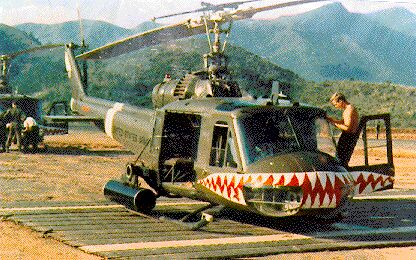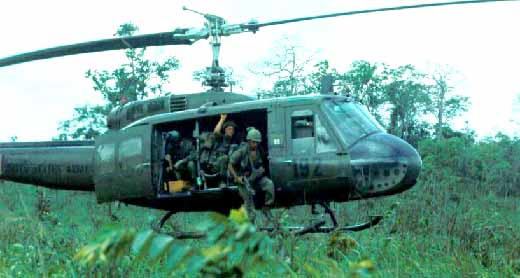Last month the Bell UH-1 helicopter takes its place in the Museum of Flight. Known as the faithful workhorse of the U.S. military during the Vietnam War. The UH1 Huey first was designated the initials HU1 leading to the nickname 'Huey'. Its official US Army name 'Iroquois' is derived from the Native American tribe. Later it was designated as UH1 but its users namely the Marines have officially designated it as Huey. The Huey played a vital part in American military operations in the 1960's and much of the Cold War years.
As Filipinos, the UH1 helicopter is the military vehicle were probably most familiar with. Constantly flying above us and that unmistakable rumbling thunderous noise accompanying it often times waking you up from sleep was sweet music for ground troops after desperate fighting during the Vietnam War, as they hauled soldiers to safety, particularly the casualties (medical evacuation or Medevac) to the nearest field hospital or M.A.S.H. (mobile army surgical hospital), thus being referred among other aircraft of the war as, "Freedom Bird". Their purpose and effect to troops to this day might not be quite so different. Many Vietnam war veterans still get emotional when hearing the Huey's distinctive sound and almost immediately evoke good and bad memories usually leaning on the bad and have described it almost like a haunting wail from past.
The helicopter was developed by Bell Helicopter company for the US Army's requirement for a medical evacuation and utility helicopter in 1952, its first flight was on October 20, 1956 and was ordered into production in March 1960. Early variants of the UH1first entered service with the 101st Airborne Division at Fort Campbell, Kentucky, namely the 82nd Airborne Division and the 57th Medical Detachment. The first helicopter medical evacuation unit to arrive in Vietnam landed in March-April, 1962. The Huey's performance in the field greatly impressed military officials and no sooner it was put to different tasks. First, troop transportation. The Huey's large cabin space gave it an opportunity to transport in large quantity - around 14 troops in combat gear, along with 6 medical flatbeds a crew up to 4, the usual (pilot, co-pilot, door-gunners).
It was by instant multi-role, utility, tranportation, air ambulance and with weapons attached came the attack helicopter. The soldiers dubbed the Huey various names to differentiate its purpose.
- Huey Army gunships armed with rocket pods were called "Hogs" and some were designated and rather effective tank-killers such as the bushmasters. Their Navy counterparts were given the name "Sharks".
- Huey attack gunships armed with machinegun armaments, miniguns, quad mountings were dubbed, "Cobras". Unarmed or transport Hueys were called, "Slicks". Their Navy counterpart were "Dolphins".
The helicopter's involvement in the Vietnam war from the October 1966 to 1975, 2,709 people have been killed in Hueys. 1,074 pilots, 1,103 crew members, 532 American passengers, although allied South Vietnam may exceeded in this number.During World War II the average infantryman in the South Pacific saw on average 40 days of combat in 4 years. During the Vietnam war an infantryman saw 240 days of combat in 1 year...Thanks to the mobility of the helicopter.
The UH-1's total flight time in the Vietnam War was 7,531,955 hours. It had more combat flight time than any aircraft in the history of warfare.
Results 1 to 10 of 36
Thread: UH-1 Iroquois Helicopter "Huey"
-
07-01-2012, 02:24 AM #1Banned User

- Join Date
- May 2012
- Gender

- Posts
- 1,464
 UH-1 Iroquois Helicopter "Huey"
UH-1 Iroquois Helicopter "Huey"
Last edited by machinecult; 07-02-2012 at 05:49 PM.
-
07-01-2012, 09:13 PM #2
 Re: UH-1 Iroquois Helicopter "Huey"
Re: UH-1 Iroquois Helicopter "Huey"
Im proud that i once put my hands on this worlds most famous helicopter, when i was on training as helimech with PAF, i could still remember the words printed on the hangar.." happiness is the sound of the huey coming home"
-
07-02-2012, 08:16 AM #3
 Re: UH-1 Iroquois Helicopter "Huey"
Re: UH-1 Iroquois Helicopter "Huey"
Cge kug sakay ani katong bata paku, kuyog2x man ko sa akoang lolo basta muad2 siya ug Cotabato City....
Helicopter were called "choppers" because of the Huey's distinctive sound...
-
07-02-2012, 08:24 AM #4
 Re: UH-1 Iroquois Helicopter "Huey"
Re: UH-1 Iroquois Helicopter "Huey"
The legend needs to rest now, it served well and long. We will miss this iconic sound : " Whoop- whoop- whoop -whoop"
-
07-02-2012, 08:59 AM #5
 Re: UH-1 Iroquois Helicopter "Huey"
Re: UH-1 Iroquois Helicopter "Huey"
Pinakasikat bitaw gyud ni nga heli
-
07-02-2012, 09:11 AM #6C.I.A.

- Join Date
- May 2012
- Gender

- Posts
- 3,859
 Re: UH-1 Iroquois Helicopter "Huey"
Re: UH-1 Iroquois Helicopter "Huey"
ang sa PAF morag after 2 decades pa before ma ilisan.
-
07-02-2012, 10:22 AM #7Newbie

- Join Date
- Nov 2011
- Gender

- Posts
- 29
 Re: UH-1 Iroquois Helicopter "Huey"
Re: UH-1 Iroquois Helicopter "Huey"
Mao ra gyud ni akong think kung "UH-1 Huey = Vietnam War"
-
07-02-2012, 11:44 AM #8
-
07-02-2012, 11:48 AM #9Banned User

- Join Date
- Nov 2011
- Gender

- Posts
- 554
 Re: UH-1 Iroquois Helicopter "Huey"
Re: UH-1 Iroquois Helicopter "Huey"
murag ba-o ang nawong aning huey helicopter
-
07-02-2012, 11:52 AM #10
Advertisement
Similar Threads |
|














 Reply With Quote
Reply With Quote


